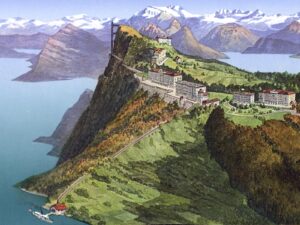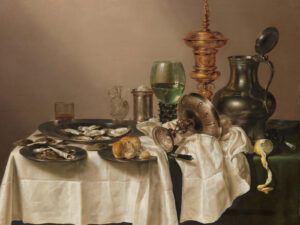
Musée d’Art et d’Histoire, Geneva
The ‘kings’ of Geneva
The Exercice de l’Arquebuse was a Geneva society which, until 1782, held a festival of marksmanship each year, which culminated in the crowning of a ‘king’. This king then ruled temporarily as monarch.
The fraternity of the distinguished Exercice de l’Arquebuse is a militaristic society in Geneva with a long history, having been first mentioned in writing in 1474. This medieval guild joined a long list of active societies. At the end of the 15th century there were around 60 societies with different structures and objectives, each under the protection of a patron. These societies were present at all public events – at blessing processions in times of famine or epidemics, and at the weddings or birth celebrations of the Princes of Savoy. The highlight of the year was the guild feast, which lasted up to three days. Since these societies were based on traditional religious customs and beliefs, they gradually disappeared, together with the ‘papal’ rituals, in the course of Calvin’s Reformation. However, some of these organisations, in particular military societies, survived after shedding the religious aspects of their identities.
The king of the marksmen (Schützenkönig)
The Exercice de l’Arquebuse emerged at a time of political and religious unrest, and recruited its members from among the citizens of the city of Geneva. The tradition of competitions and kingship was a central pillar of the organisation’s existence. The society’s edict of 1474 stipulated that ‘three prizes of six guilders each must be awarded, one for crossbow shooting, one for archers, and one for firearms shooting’. Shooting competitions, known as Exercice, were held within the city walls, from the Rue de Rive to the Rue du Lac, from 1475 onwards. Each year there was also a marksmen’s contest, on the third Sunday after Easter, called the Coup du Roi. The first man to shoot down the papegay (parrot or popinjay), as the target was called, was crowned ‘king’ of the marksmen’s festival. He held the title for a year, and enjoyed both fiscal and honorary privileges. For the year of his reign, this ‘king’ was attended by a field marshal, who soon became known as the Seigneur-Commis (chairman), as well as a treasurer and a secretary.

The society’s Royal Hall (Königssaal) is part of a stately home belonging to the Exercice de l’Arquebuse.
by courtesy
A very insular club
As the aristocratisation of Geneva’s elite proceeded, the Exercice de l’Arquebuse increasingly became a springboard to power, the exclusive preserve of the upper echelons of noble society. In 1607, several guild members submitted a petition asking that ‘guaicts [watchmen], officiers [police officers] and portiers [gatekeepers] be banned from shooting the arquebus [an early muzzle-loaded firearm] at tax-exempt tournaments, as such people must not be allowed to become king’. With bans and exclusions brought in, the Exercice soon became a very insular club. The society was now a place for the powerful and the wealthy, and so the rituals were soon expanded with much pomp – greatly at odds with the extensive ordinances in place, compliance with which the moral court struggled to enforce. Especially on the occasion of the ‘coronations’, extravagance and pageantry took on ostentatious proportions; skill with a firearm now played a very minor role. When Hans-Rodolph Werdmüller was crowned king in 1530, as the new ‘sovereign’ he laid on food and drink for the whole city.
A few decades later, Abel Chenevière combined honorary privileges when, as ‘king’ of the Exercice du Canon, he bought the ‘kingship’ of the Exercice de l’Arquebuse. In May 1674 he asked to be exempted from all the duties he had accrued on goods the previous October. The council exempted him from these duties ‘in consideration of the old privileges granted to the kings of the said Exercise’. But his son, Jean, pushed the ostentatious self-indulgence even further. Jean Chenevière had in his turn become the ‘king’ of the Exercice de l’Arquebuse in 1725, at a time when the organisation’s extravagant, splendid excesses made the moral court turn pale. A prerequisite for the ‘kingship’ was personal wealth which, in addition to providing the surety for guarding the treasury of the arquebus, was used to finance the traditional feast and the festivities which had become public in the late 17th century. That meant all manner of finery and parades on the Plaine de Plainpalais as a symbol of the society’s hierarchical structure, flaunting its wealth and status.
Regal procession
To mark his coronation, Jean Chenevière commissioned the painter Barthélémy Guillebaud to paint his portrait. For Chenevière’s coronation, guild officials asked the city’s Kleine Rat (Small Council) to permit the use of a company of cavalry and a militia company, which was to be flanked by infantrymen. The council members accepted the request without demur. They proposed only that ‘the gentlemen, princes and emissaries of all nations who were present in the city’ should also be invited to the ceremony. There were many such people in the city of Calvin at that time. The princes of Saxony, Brandenburg and Luxembourg, the Count of Marklay and 140 other distinguished foreigners of high standing accepted the invitation. Only the French envoy declined, on health grounds.
The ceremony began at midday on 6 July 1725. In the town hall, ‘King’ Jean Chenevière received the foreign princes and noblemen in the first antechamber. The assembled guests then sat down to luncheon, at which one toast to the health of the new ‘sovereign’ followed the next. After coffee, the ‘king and his retinue’ watched the parade of troops provided for the occasion. The ‘king’ followed along with the municipal authorities and the foreign nobility. As they processed through the city, they were cheered and applauded by the general public, accompanied by the thunderous boom of cannon fire resounding from the city walls. And that was just the beginning! The throng then gathered on the Plaine de Plainpalais, in an amphitheatre built specially for the event. A battle re-enactment began: the sound of gunfire – attack by the dragoons – pistol shots ringing out – the infantry in rank and file, firing at the command of their officers – accompanied by the beating of drums. The rain finally put an end to the festivities, and prevented the parade of the infantry corps. At seven o’clock in the evening, Jean Chenevière was accompanied home by the entire city, where he was able to enjoy the end of the festive procession.

Jean Chenevière, painted by Barthélémy Guillebaud, 1725.
Christophe Vuilleumier
This level of pomp and pageantry as an expression of aristocratisation continued until 1781, when the people rose up against the aristocracy and forcibly imposed a democratic constitution. Thanks to the Bernese, French and Sardinians, who besieged the city and restored the ‘old’ order, the aristocracy managed to survive this assault. And that’s not all: the aristocracy disbanded the militia, which had become too dangerous for its tastes. The people’s army was replaced by a professional garrison made up of numerous government-paid mercenaries.
Prohibition and re-establishment
The many upheavals that Geneva society experienced from then on didn’t spare the venerable old societies, including the Exercice de l’Arquebuse. On 4 November 1782, these societies were banned. Ten years later, the revolution drove out the old aristocracy, reintroduced the principle of the citizens’ militia, and re-established the Exercice de l’Arquebuse. This seems paradoxical, since the Exercice had for nearly two centuries been a province jealously guarded by the city’s most powerful families. But even though shots rang out again and ‘kings’ were crowned, there was no longer any trace of the self-indulgent opulence of the past centuries. Instead, the Exercice now holds its wealth in a more discreet and long-lasting manner, in the form of real estate.

Parade of the Exercice de l’Arquebuse society in Geneva in 1903.
Wikimedia



